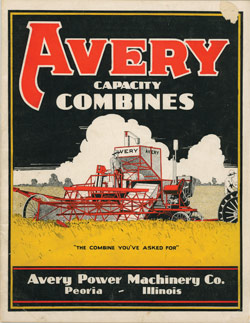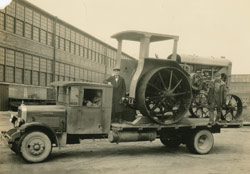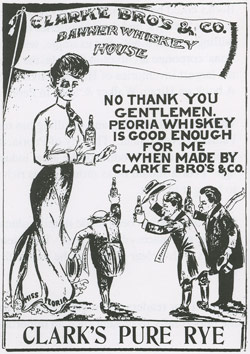If one might be permitted to amend the remark by Calvin Coolidge which goes, “The business of America is business,” it might read, “The business of Peoria is making things.” For about the time that President Coolidge made that observation, it was claimed that 900 items bore the title, “Made in Peoria.”
To detail all these products is impractical, but they included everything from cigars and bicycles to bricks and plows, nails and gloves, crackers and pottery, wagons and barbed wire, tombstones and rope, washing machines and caskets, automobiles and peanut roasters, oil burners, kitchen ranges, lawn sprinklers, lift trucks, steel fabrications, and, of course, tractors, beer and whiskey.
For several decades, “making things” was Peoria’s very reason for existence. The practice was fueled in the beginning by the river, which not only made this city a destination for all kinds of imports, but an export point from which all manner of goods could be shipped. This was long before paved roads or railroads, when river shipping was the only way to go, giving river cities a head start in the business of making things. And among the earliest products of the “Made in Peoria” era were whiskey and beer.
 Distilleries & Breweries
Distilleries & Breweries
These days, with the breweries and distilleries long gone, it might be hard to imagine that Peoria once was the whiskey capital of the world. No place on earth produced so much bourbon and rye as that which came from local distilleries. So great was the revenue from the whiskey tax that Peoria’s share of these taxes paid to the federal government was larger than any other city in the United States. Chicago was second, and Cincinnati was third.
The city’s first distillery was built by Almiran S. Cole in 1843. It stood along the river at the foot of Oak Street. Cole soon sold out, but returned to whiskey making in 1850 with partners Benjamin Bourland, Tobias Bradley and William Moss, a steamboat captain and the brother of Lydia Moss, who later married Tobias Bradley and became the founder of Bradley University.
From these beginnings, Peoria became the center for beer and whiskey making. Between 1837 and 1919, there were 24 breweries and 73 distilleries in operation here. It was, at its peak, the largest corn-consuming market in the world.
In 1881, Joseph Greenhut, the quintessential whiskey baron, built the Great Western Distillery, which was known as the largest distillery in the world. The title was later claimed by Hiram Walker & Sons, who purchased the facility in 1933, and then ADM, who took it over in 1982.
While it lasted, distilling was the leading industry, producing an estimated 18.6 million gallons of alcohol a year. Many of the houses along Peoria’s High Street and Moss Avenue owe their existence in one way or another to whiskey, for distilling spawned a host of related businesses. It required woodcutters, sawmills and barrel makers. The resulting sawdust was used by ice houses in the summer. Since one of the byproducts of whiskey was wet mash or slop, which made an excellent food for cattle, huge herds were maintained in an area near the foot of Western Avenue. As many as 28,000 animals munched contentedly on this alcoholic mash.
The presence of all these cattle made Peoria a major center for the dairy industry and for meat-packing houses. Other offshoot occupations included delivery wagons, repairmen, veterinarians, blacksmiths, farriers, shippers, drovers, stockyard workers, label printers and even workers whose specialty was caulking leaking whisky barrels with papyrus.
 The production of beer was perhaps not quite so spectacular. Andrew Eitle established the first brewery here in 1837, just south of the present-day Bob Michel Bridge. Nearby, John Gipps opened his brewery, which became famous for its motto, “Gimme Gipps.” The Leisy Brewery was founded in 1884 on the site of the former City Brewery. It remained in operation until Prohibition, when it was sold to Premier Malt Products Company. It is now the site of PMP Fermentation.
The production of beer was perhaps not quite so spectacular. Andrew Eitle established the first brewery here in 1837, just south of the present-day Bob Michel Bridge. Nearby, John Gipps opened his brewery, which became famous for its motto, “Gimme Gipps.” The Leisy Brewery was founded in 1884 on the site of the former City Brewery. It remained in operation until Prohibition, when it was sold to Premier Malt Products Company. It is now the site of PMP Fermentation.
Premier eventually became associated with the Pabst Brewing Company, which built a new plant in Peoria Heights in 1933. This plant closed in 1982. Today, the only beer made in Peoria is by home brewers and at a few brew pubs, and the only distillation occurs at ADM in the form of ethanol and neutral grain spirits. But the legacy remains, not only in the grand mansions and the so-called “old money,” but the fact that booze and a wide-open city gave Peoria a reputation it has never quite shed.
There is another legacy as well. It involved Joseph Greenhut, who hired an eminent Japanese scientist, Dr. Jokichi Takamine, to come to Peoria to apply a new process to the making of alcohol. It was never achieved, but Dr. Takamine went on to become famous for his work with adrenaline—and for his purchase of 2,000 cherry trees to be planted around the Tidal Basin in Washington, D.C. Every year, the national Cherry Blossom Festival is celebrated beneath the trees donated by a man brought to Peoria by the whiskey trust.
 Earthmoving & Manufacturing
Earthmoving & Manufacturing
While the distilleries and breweries brought astonishing wealth to so many in such a short time, its demise still left the city with the unchallenged title of earthmoving capital of the world. Today, it is Caterpillar which assures the claim to the title. In recent years, “Big Yellow” has molded Peoria’s economy with its massive workforce, its wages and benefits, and its international reach. But before Caterpillar, there was Avery, the city’s major industrial presence, which was located in what was then known as Averyville.
In 1898, the Avery Company was capable of producing 250 grain separators a year, 150 threshing engines, 225 self-feeders for grain separators, 3,000 corn planters, 1,500 stalk cutters and 2,000 farm wagons, plus countless steel-wheel tractors. A 1913 article in The Peorian boasted that “Avery machines are bearing the name ‘Peoria’ to all parts of the globe.” In 1920, it employed 20,600 workers in the plant formerly known as the Kingman Plow Company. But in 1924, the firm went broke. What remained were the buildings, the town of Averyville and the farm machines that are now collectors’ items.
The empty plant was eventually purchased by Robert Gilmour LeTourneau, who had located in Peoria in 1935, setting up shop between the site of Woodruff Field and the Avery plant. He bought the Avery Company in 1941, and during World War II, produced hundreds of Tournapull scrapers, dozers, rooters and rollers for military roads and airfields. His famous Tournapulls could move 27 tons of earth at 17 miles per hour. LeTourneau, who said that God runs his business, sold his plant to Westinghouse Air Brake Company (WABCO) in 1953. It later became home to American Standard, Dresser, Komatsu-Dresser and now Komatsu. A statue of LeTourneau now stands near the tennis courts in Glen Oak Park.
Keystone, the other major industrial presence, was founded in 1889 by Peter Sommer, a tenant farmer near Dillon, Illinois. He began producing wire fence on a crude machine he had cobbled together in a barnyard shed. He later moved to Tremont, then to South Adams Street in Peoria and finally Bartonville, where Keystone has been the dominant presence in town since 1900. Keystone fence was advertised as being “horse high, pig tight and bull strong.” Some 2,000 miles of its fence were sold to the King Ranch in Texas, and the company sponsored several radio programs, including the WLS Red Brand Barn Dance, live from Chicago. Keystone remains a major employer in central Illinois.
Caterpillar is unquestionably the predominant business and industrial presence in the area. It started somewhat inauspiciously in 1910 at a time when Peoria had a wealth of prosperous industries, cranking out everything from plows and bicycles to automobiles, tractors and washing machines. Then, the Holt Caterpillar Co. operated out of a small East Peoria plant that employed 65 people by year end.
At a time when Horace Greeley was urging Americans to go west, the California-based Holt Manufacturing Company decided to add a plant in the east. Holt was at the point of locating in Minneapolis, but was convinced by Murray Baker, a Peoria tractor distributor, to buy the bankrupt Colean Manufacturing Co. plant in East Peoria. The company began its major growth during World War I, as the Holt Caterpillar track-type tractor proved adept at dragging heavy artillery equipment through the mud of the Western front. Thousands of these tractors were sold to the Allies.
Caterpillar Tractor Co. was formed in 1925 when the C. L. Best Tractor Co. and The Holt Manufacturing Company were merged into the new company. Originally based in California, the company’s headquarters were relocated to the East Peoria plant in 1930. While it survived the Depression, the company received a major boost from the outbreak of World War II. Initially, it provided transmissions for tanks, howitzer carriages and bomb fuses, along with its tractors. By 1943, it resumed full-time production of tractors, which became famous for their role in building the Burma Road, for leveling South Pacific islands for runways, and for clearing the London streets of rubble during the Battle of Britain.
Today, with its plants spread around the world, Caterpillar no longer dominates Peoria as it once did. The healthcare industry has moved into second place in a strictly business sense, and the economy has diversified since the days when Caterpillar vacation meant a virtually empty city. But it is still the big player.
When Pliny Holt was negotiating the purchase of the Colean plant in East Peoria, he wrote to Murray Baker, “I am sure that this marks the beginning of one of the largest enterprises in the Middle West, and assures the city of Peoria of an industry that they will be proud of in the future.” Prophetic words indeed. After more than 100 years, Caterpillar and Peoria remain virtually inseparable.
While there are no longer 900 items bearing the “Made in Peoria” label, this remains a community that has been enriched by what it has produced over the years and by the people who have planned, worked and sweated to make it happen. They have made this a very special city. iBi
Jerry Klein is a longtime writer with the Peoria Journal Star and columnist with The Catholic Post. He is the author of numerous books on Peoria history.


